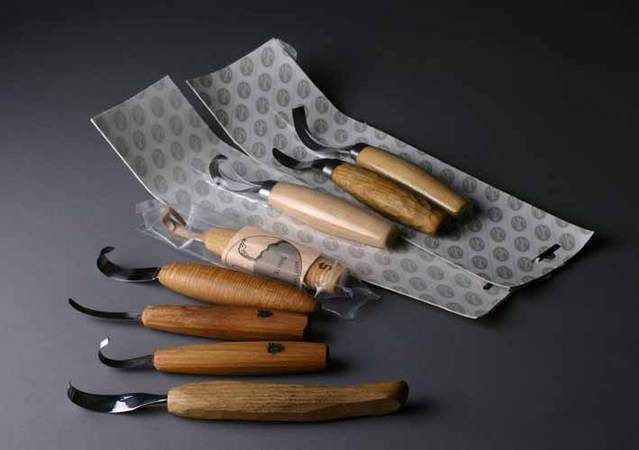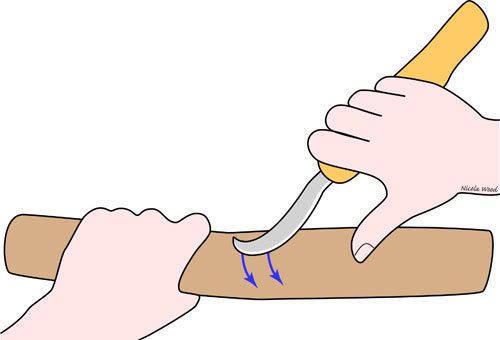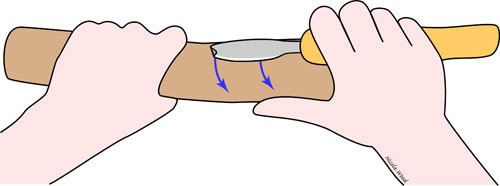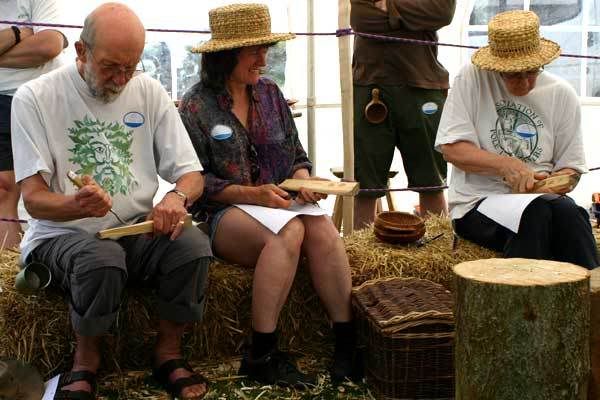Last Sunday I gathered together a group of spoon makers from fairly novice to very experienced for a more systematic test of the hook knives. Eight people, eight knives, eight fairly similar blocks of lime to scoop into. They had a few minutes with each knife, time to write a few comments, then they passed it around the circle. (Robin took some photos of the set up, hopefully he'll post them later.)
The knives

from bottom (l) to top (r): Bo Helgesson, Ben Orford - deep curve, Ben Orford - shallow curve, Del Stubbs, Svante Djarv, Frosts - deep curve, Frosts - Robin modified, Frosts - double edged
A summary of their feedback
Bo Helgesson (Helgess)
Blade largely felt to give a good cut and to be versatile for both shallow and deep cuts. Handle ok, but would have been better if blade set further in.
Ben Orford - deep curve
Comments on the blade were largely positive, although best for small, deep hollowing. The faceted handle was admired, but too slim many hands.
Ben Orford - shallow curve
Comments on the blade were again largely positive, although best for shallow work. Comments on handle as before, admired but too slim for many hands.
Del Stubbs
Comments on the blade were mixed with as many positive as negative. The handle was largely disliked for being too smooth.
Svante Djarv
Comments on the blade largely positive, although best for small, deep hollowing. Handle pleased most people.
Frosts - deep curve
Mixed response to the blade; those who got it working found it worked ok but some couldnt get a clean cut and some couldnt get it to work at all. Handle ok, but some found it a bit fat.
Frosts - Robin modified
The curve of the blade was found to be rather shallow and a little short, but more versatile. Modified handle largely felt to be an improvement.
Frosts - double edged
Most thought the curve of the blade too shallow to be useful and felt the double edge was not of use and was dangerous. Handle as above.
Reviewers summary comments
Those who expressed a preference at the end chose the Ben Orford - deep curve, Svante Djarv & Bo Helgesson. Several comments about the importance of sharpening; getting them really sharp and keeping them that way. Finally some advice from one reviewer: different ones will suit different makers and their style and method of working. Start with a cheap Frost, good honest working tool, then try out as many different types as you can before upgrading.
My comments
From watching and talking to both these reviewers and learners on courses is that the deep, even curves like the Ben Orford - deep curve, Svante Djarv, Frosts - deep curve work well in small, deep shapes and it is easy to get an aggressive cut. However on a larger or more open shapes they tend to leave a ploughed field effect. To remove this you either need a second knife with a shallower curve like the Ben Orford - shallow curve, Frosts - double edged, Frosts - Robin modified or vigorous application of sandpaper (yuk!)
If you want to use just one knife you need a more complex curve that offers both the deep and broader curves and you need to learn how to manipulate it. To use the tighter curve for aggressive, deep cuts you need to hold it more upright:

To use the flatter curve for smoother cuts - and for gentle starting out cuts as you first start to hollow - you need to use it at a lower angle:

Obviously, you can use it at many in-between stages as well.
I like this, which is why I get on well with the Bo Helgesson hook although the Dell Stubbs hook has a similar profile but doesnt work as well for me. I also tried a Svante Djarv knife with a similar profile that belonged to one of the reviewers and it seemed to offer the same potential, although it was not very sharp at the time. I tried a Ben Orford knife of a similar profile belonging to another of the reviewers, but found the distance from the handle to the steep curve too long so I could not use it in a sufficiently upright position.
Interesting stuff?!
Nicola
The knives

from bottom (l) to top (r): Bo Helgesson, Ben Orford - deep curve, Ben Orford - shallow curve, Del Stubbs, Svante Djarv, Frosts - deep curve, Frosts - Robin modified, Frosts - double edged
A summary of their feedback
Bo Helgesson (Helgess)
Blade largely felt to give a good cut and to be versatile for both shallow and deep cuts. Handle ok, but would have been better if blade set further in.
Ben Orford - deep curve
Comments on the blade were largely positive, although best for small, deep hollowing. The faceted handle was admired, but too slim many hands.
Ben Orford - shallow curve
Comments on the blade were again largely positive, although best for shallow work. Comments on handle as before, admired but too slim for many hands.
Del Stubbs
Comments on the blade were mixed with as many positive as negative. The handle was largely disliked for being too smooth.
Svante Djarv
Comments on the blade largely positive, although best for small, deep hollowing. Handle pleased most people.
Frosts - deep curve
Mixed response to the blade; those who got it working found it worked ok but some couldnt get a clean cut and some couldnt get it to work at all. Handle ok, but some found it a bit fat.
Frosts - Robin modified
The curve of the blade was found to be rather shallow and a little short, but more versatile. Modified handle largely felt to be an improvement.
Frosts - double edged
Most thought the curve of the blade too shallow to be useful and felt the double edge was not of use and was dangerous. Handle as above.
Reviewers summary comments
Those who expressed a preference at the end chose the Ben Orford - deep curve, Svante Djarv & Bo Helgesson. Several comments about the importance of sharpening; getting them really sharp and keeping them that way. Finally some advice from one reviewer: different ones will suit different makers and their style and method of working. Start with a cheap Frost, good honest working tool, then try out as many different types as you can before upgrading.
My comments
From watching and talking to both these reviewers and learners on courses is that the deep, even curves like the Ben Orford - deep curve, Svante Djarv, Frosts - deep curve work well in small, deep shapes and it is easy to get an aggressive cut. However on a larger or more open shapes they tend to leave a ploughed field effect. To remove this you either need a second knife with a shallower curve like the Ben Orford - shallow curve, Frosts - double edged, Frosts - Robin modified or vigorous application of sandpaper (yuk!)
If you want to use just one knife you need a more complex curve that offers both the deep and broader curves and you need to learn how to manipulate it. To use the tighter curve for aggressive, deep cuts you need to hold it more upright:

To use the flatter curve for smoother cuts - and for gentle starting out cuts as you first start to hollow - you need to use it at a lower angle:

Obviously, you can use it at many in-between stages as well.
I like this, which is why I get on well with the Bo Helgesson hook although the Dell Stubbs hook has a similar profile but doesnt work as well for me. I also tried a Svante Djarv knife with a similar profile that belonged to one of the reviewers and it seemed to offer the same potential, although it was not very sharp at the time. I tried a Ben Orford knife of a similar profile belonging to another of the reviewers, but found the distance from the handle to the steep curve too long so I could not use it in a sufficiently upright position.
Interesting stuff?!
Nicola


